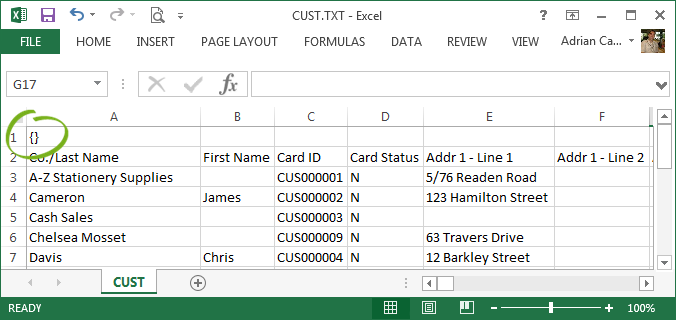To use an import templateNeed to import data an accounts list in to into MYOB but not sure where to start? The easiest way is to create an import template and populate it with your data, ready for importing. You can create the template by exporting the accounts list from MYOB. The export file becomes your template. To use the template, open it in Microsoft Excel and update its contents with the your accounts data you want to import. You can then import the file into MYOB. OK, let's step you through it. | UI Expand |
|---|
| title | 1. Create the import template |
|---|
| - Click your business name and choose Import and export data.
- Click the Export tab.
- For the Data type choose Chart of accounts.
- In the Balances from field, choose the year you want the account balances to be reflected from.
- Choose the Account balances to be included in the export.
- Click Export. The file will be exported as a tab-separated TXT file. The first row will be a header row, listing all field headers.
You can now open the export file in a spreadsheet program, like Microsoft Excel, to enter your accounts info. |
| UI Expand |
|---|
| title | 2. Use the import template |
|---|
| Use the import templateNow that you have a template, you can open it in Excel and replace the contents with your data - ready for importing. Here's how: - Open Microsoft Excel.
- Go to File > Open.
- For the type of file, select All Files(*.*). This ensures you'll be able to find your import template which is a text (.TXT) file.
 - Locate and open your exported text file. The Text Import Wizard appears.
- In Step 1 of the Text Import Wizard, select the Delimited option, then click Next.
- In Step 2 of the Text Import Wizard, select the Tab option, then click Next.
- In Step 3 of the Text Import Wizard, click Next.
Click Finish. The file contents of your template will be displayed. Notice in our example: the first cell contains parentheses (brackets) - these need to remain, as they indicate that the import file is from MYOB. the second row (beneath the row with the brackets) is labeled so you can easily work out what type of information is displayed in each column.

Delete the data from row 3 down. This is the data from MYOB which you don't need. Remember to leave the brackets on the first row, and the headings on the second row. - Enter your data in each applicable column. Remember - when viewing an import file in Excel:
- each column in the import file represents a field in MYOB.
- each row in the import file represents a different account.
When you're done, save the template as a text (.TXT) file. If you like, you can give the file a meaningful name, such as "Accounts List Import" or similar. | UI Text Box |
|---|
| Save in the correct format The easiest way to ensure your template is saved in the right format, after making your changes to the file attempt to close Excel and you'll be prompted to save. Click Yes and accept the default file type Excel suggests. Here's an example: 
|
Your template is now ready for importing. |
| UI Expand |
|---|
| title | 3. Import the prepared template |
|---|
| Import the prepared templateBy importing the prepared template you'll overwrite the existing accounts list with the new accounts list from the file. Be sure this is what you want to do before proceeding. - Click your business name and choose Import and export data.
- On the Import tab, for the Data type choose Chart of accounts.
- Click Browse and locate your import file template.
- Click the import file then click Open.
For the option If duplicate records are found, select Update existing data. - Click Import.
|
|